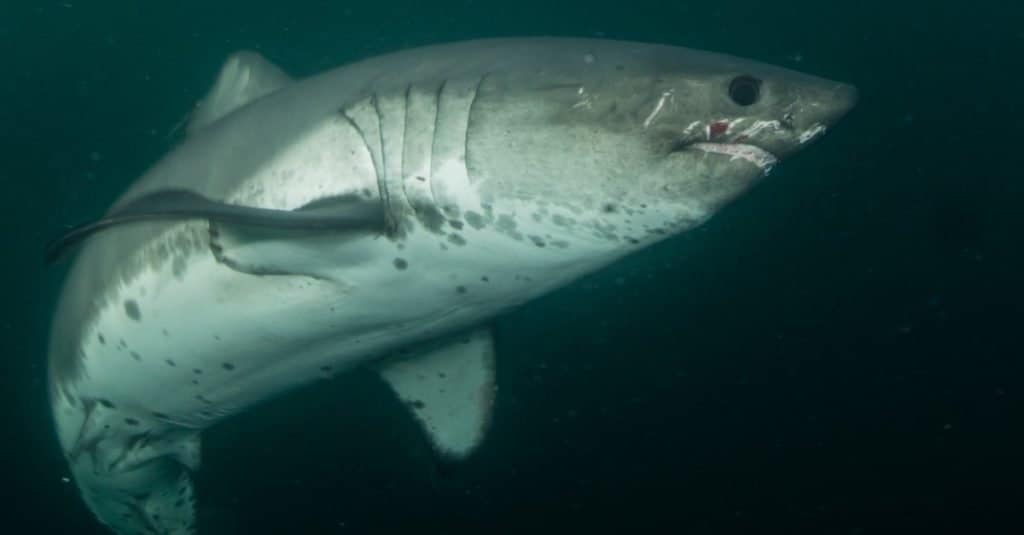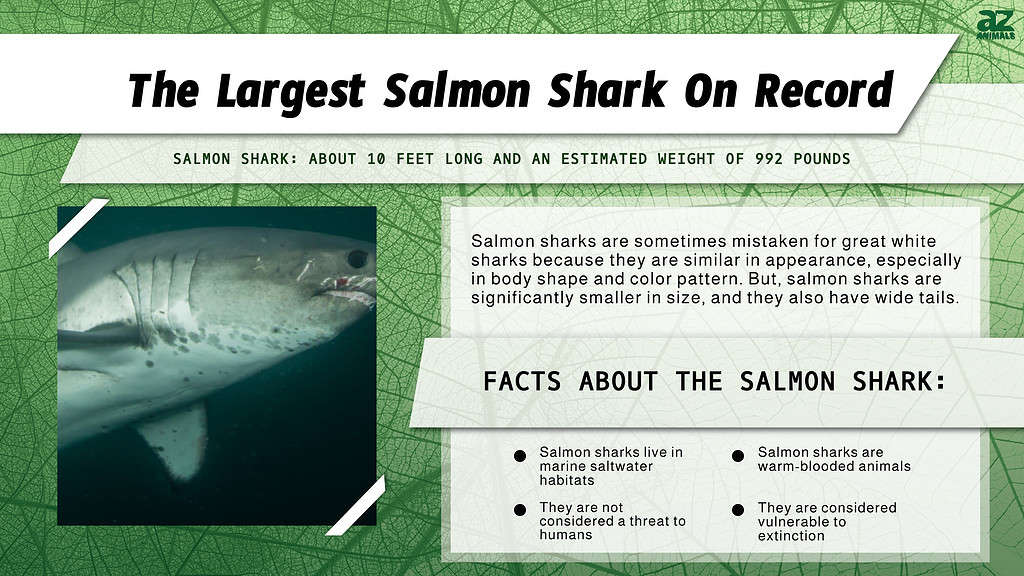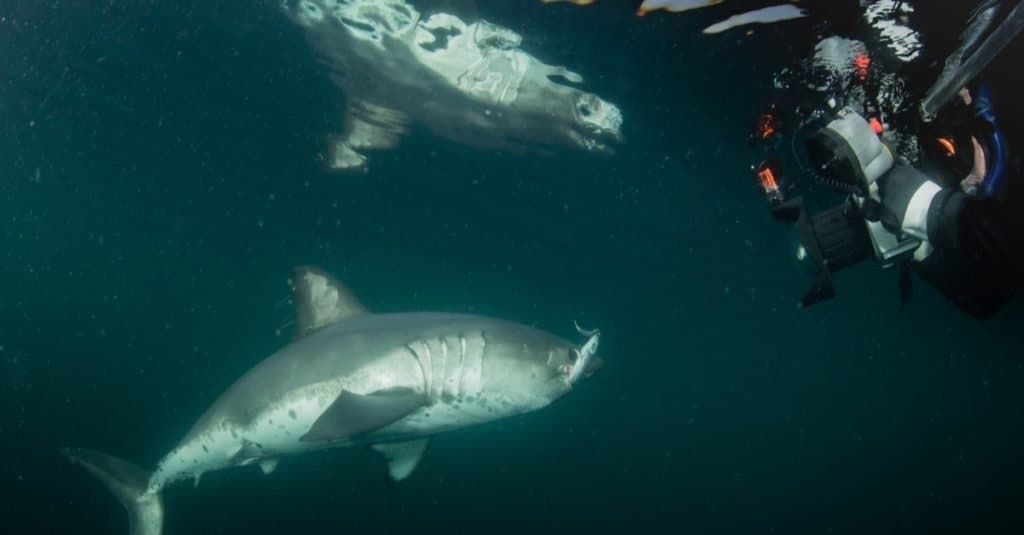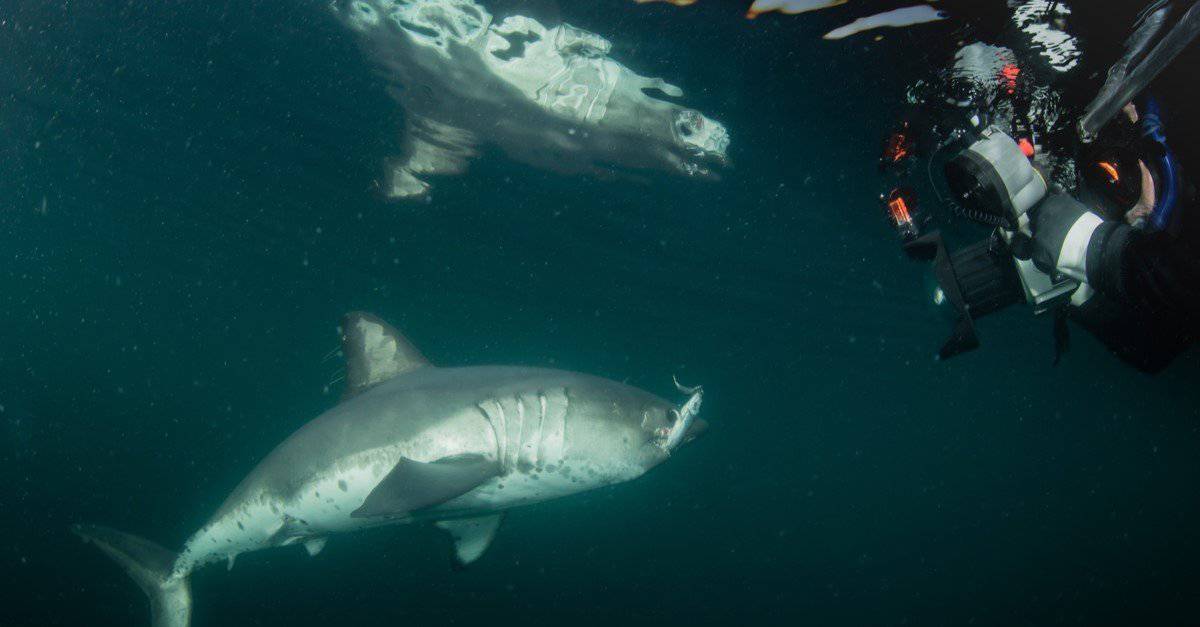Named for their love of salmon fish as a primary meal, salmon sharks live in marine saltwater habitats. They are large mackerel sharks frequently mistaken for great white sharks because of the similarity in appearance of the two species. Salmon sharks have an average length of 6-8 feet, which is much smaller than the great whites, known to grow up to 16 feet in large female individuals. In this article, you’ll discover the largest salmon shark on record.
How to Identify Salmon Sharks

Salmon sharks are sometimes mistaken for great white sharks because they are similar in appearance.
©Warren Metcalf/Shutterstock.com
Adult salmon sharks are identifiable by their medium gray to black body, with a pale white underside and dark blotches. Juveniles of this species appear similar but generally lack blotches on their underside. The snout is short and cone-shaped. Salmon sharks are sometimes mistaken for great white sharks because they are similar in appearance, especially in body shape and color pattern. But, salmon sharks are significantly smaller in size, and they also have wide tails. Juvenile sharks are smaller, as expected, but are generally identical.
Where Do Salmon Sharks Live?

Salmon sharks occur in the North Pacific Ocean, in both coastal waters and the open ocean.
©Warren Metcalf/Shutterstock.com
Salmon sharks are common in offshore waters but range from coastal to just off beaches. Salmon sharks range from the sub-Arctic to subtropical waters, as far north as Alaska and as far south as the Sea of Japan. They occur in the North Pacific Ocean, in both coastal waters and the open ocean. Some specimens of this species have been observed diving as deep as 2,192 feet, though they spend most of their time in epipelagic waters.
Interestingly, differences in range depending on sex and age have been observed between western and eastern North Pacific populations. Eastern populations of salmon sharks are dominated by females, while the western populations are primarily male. The cause of this separation is not exactly known.
Are Salmon Sharks Cold-Blooded?
Unlike most fish species, salmon sharks are warm-blooded animals. Despite fluctuations in the water temperature around them, these sharks can regulate their own body temperature using countercurrent heat exchangers, also called retia mirabilia. This exchanger is a network of arteries and veins in close proximity to each other, creating heat within the shark’s body. This mechanism reduces heat loss and allows the shark to thrive in cool temperate waters.
Some of these colder waters covering vast areas include the Sea of Okhotsk, the Bering Sea in the Northeast Pacific, and waters in Southern Baja California near Mexico. Many sea creatures are cold-blooded, relying heavily on the temperature in the surrounding water. However, salmon sharks are different in this regard.

How Big Do Salmon Sharks Get?
Salmon sharks generally grow between 6 and 8 feet in length and weigh about 485 pounds. Males are slightly smaller than females, a trait common in sharks.
What Is the Largest Salmon Shark on Record?

The largest salmon shark recorded measured 10 feet long.
©Warren Metcalf/Shutterstock.com
Though salmon sharks can grow between 6 and 8 feet long, there have been reports of some significantly longer individuals. The largest salmon shark on record is a heavily built shark with a maximum total length of about 10 feet, and an estimated weight of 992 pounds. However, there are unconfirmed reports of salmon sharks reaching as much as 14.2 feet.
What Do Salmon Sharks Eat?
The primary source of food for the salmon shark is Pacific salmon — hence its name. Despite its main diet, the salmon shark is an apex predator that feeds on a wide variety of other marine fishes, including herring, codfish, sablefish, and squid. Sometimes, they also feed on birds and sea otters. Meanwhile, salmon sharks are sometimes hunted by other larger sharks, their biggest natural predator.
Do Salmon Sharks Attack Humans?
There have been only a few reports of salmon shark attacks on humans, even though they are thought of as capable of causing injuries to humans. Divers have reported encountering salmon sharks in the ocean, and sometimes, these sharks even bump into fishing vessels. However, they are not considered a threat to human beings.
Are Salmon Sharks Threatened?
Salmon sharks are considered vulnerable to extinction, possibly due to being frequently captured as bycatch. They are not threatened by commercial fisheries, because they are often regarded as nuisances since they damage fishing gear and consume portions of the intended commercial catch. Fishermen have also been reported to injure these sharks deliberately. In Alaska, sports fishermen hunt salmon sharks. For this reason, fishing regulations in the state have limited the catch to two salmon sharks per person per year.
In British Columbia, however, sports fishermen are allowed one per day from April 1 to March 31. When salmon sharks are caught, their flesh is used for human consumption, which is uncommon in the United States. Products like leather and fish oil are often made from captured salmon sharks. Their fins can also be cut off and sold. Another interesting fact is that their heart is considered a delicacy in the Japanese city of Kesennuma, Miyagi, for use in sashimi.
Thank you for reading! Have some feedback for us? Contact the AZ Animals editorial team.








